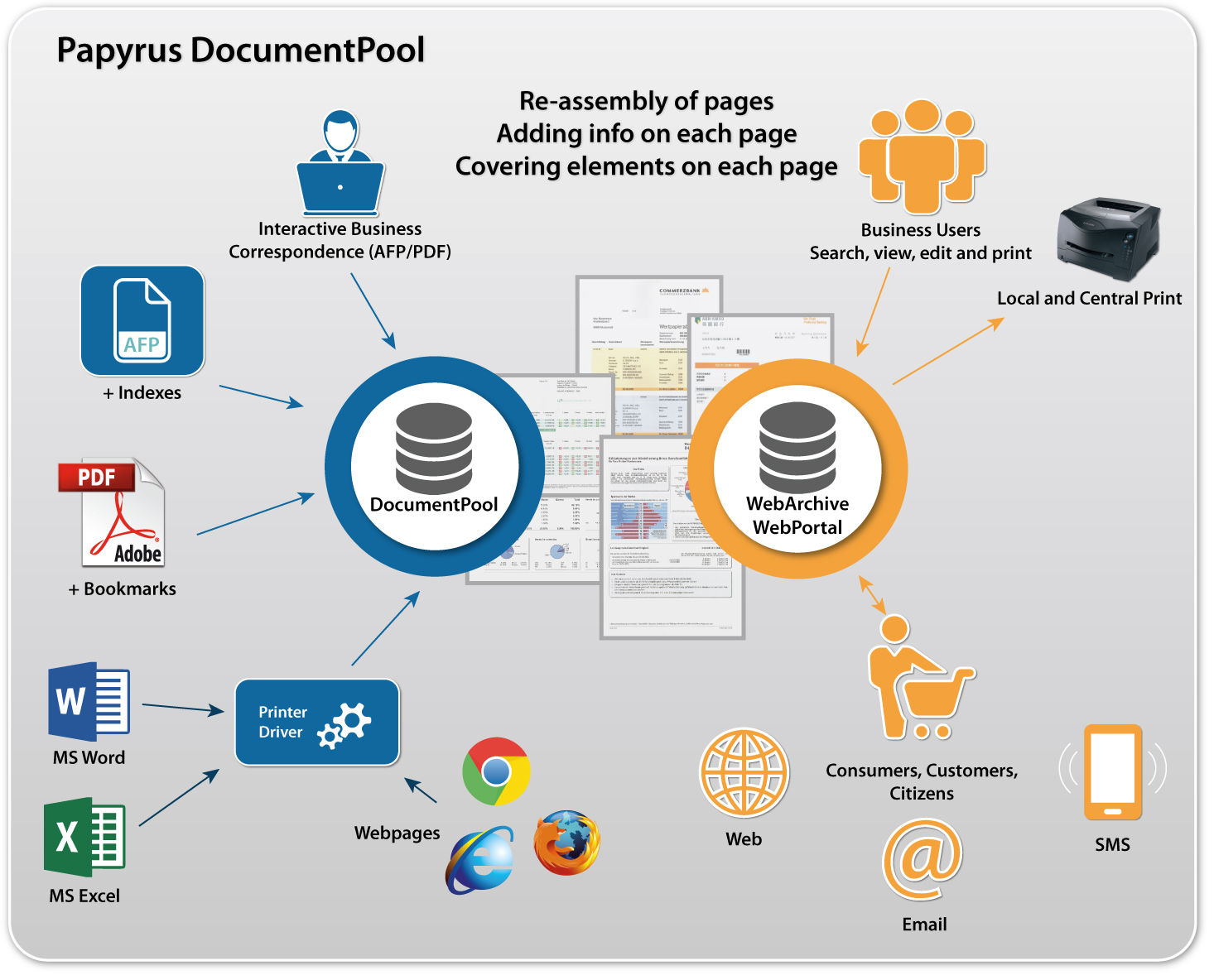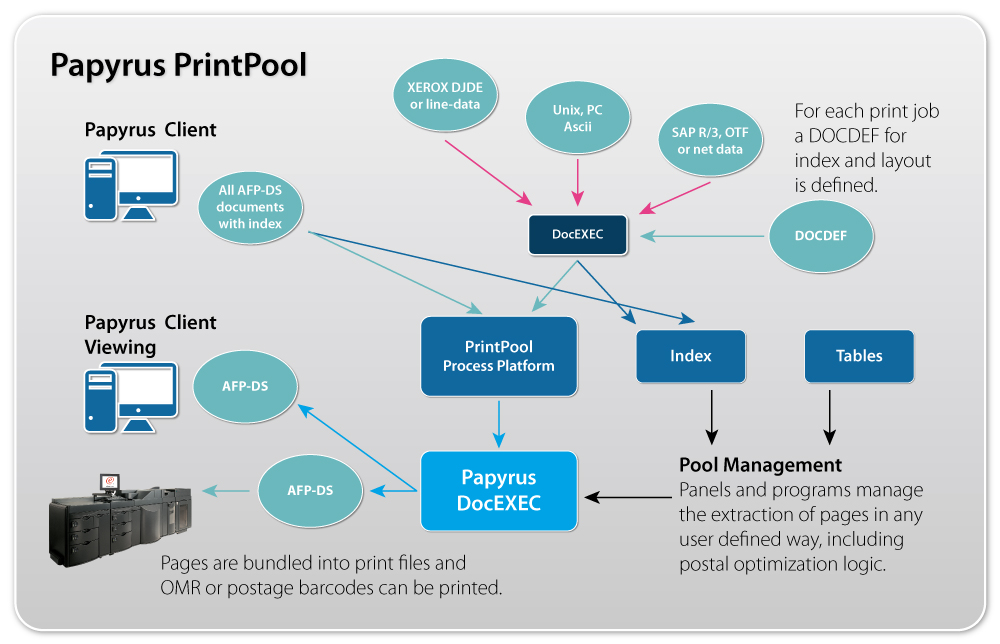Product Description
Papyrus DocEXEC and PostCalc add the capability for output management and postal optimization to the Papyrus Document System. This functionality is available for z/OS, UNIX, Linux and Windows. The unique concept of pooling the print based on single documents replaces the conventional file spooling.
The bundling, distribution and postal optimization features provide important opportunities for cost reduction. This is achieved by reducing both the number of printouts and the number of envelopes sent and by optimizing the postage per item based on available discount structures.
- Develop bundling with Papyrus Designer including index and control information.
- Convert and manage all output types as page-mode documents in 240/300/600 dpi.
- The Papyrus PostCalc product is postal authorities certified and can be used to calculate postage and optimize print volumes for discounts.
- Provides document distribution, re-printing, OMR and bar code printing, envelope merging and splitting.
Features
The DocumentPool
Bundling can be performed for various applications, running on any supported platform and at any time. A customer letter produced on a clerk’s workstation could, for instance, be bundled with a bank statement or an insurance policy produced on the mainframe.
All documents to be processed are either sent via queue directories, FTP, SNA RJE or a z/OS JES submitted job and will be automatically stored, or formatted and stored in the DocumentPool together with their corresponding indexes.
Due to the free choice of database and the highly configurable applications, the bundling logic is completely flexible and easily expendable.
Use any kind of input data
- Mainframe batch lists or online via CICS queues and MQ Series
- Unix print formats (ASCII)
- SAP print formats
- Client/Server data files (e.g. XML)
- Direct database access
- ACIF indexed AFP files
- Any text file format
Collate and distribute
- Automatic, scheduled or manual start of bundling process
- Grouping of documents for a user, a complete department or into one envelope per customer
- Grouping can be based on the input type, the user, or on data contained in the document
- Allows to print OMR and bar code to the collated group of pages
Group sequence
- Prioritize based on users, documents or combinations of both
- Prioritize based on total page numbers
- Users can define criteria themselves at the time of bundling
Storage management
- Single AFP pages are typically less than 10 kB in size
- The DocumentPool database requires a high performance storage solution (HDD or preferably SSD), RAID and SAN architectures are of advantage
- Storage of documents in AFP, PDF, TIFF or GIF format
Distribution of documents
- Central printing of documents on mainframe- or server-systems
- Decentralized printing on client workstations
- Distribution via fax servers
- Transfer to archive systems
- Distribution of documents via email or web portals
Previewing and reprinting
- Business users decide whether to print or not to print documents
- Each document can also be reprinted individually
- Index can be used for quick search
- Documents can be viewed on client workstations
- View documents on Internet/Intranet
- Print to IPDS, IJPDS, Xerox, PCL, Postscript, and fax
- Distribution as email attachment
General aspects of bundling
The DocumentPool can only be used in combination with a Papyrus DocEXEC installation and can be operated on z/OS or server platforms. For storing documents the DocumentPool requires a Papyrus Depot Node when running in a Papyrus WebRepository setup. Alternatively an external database such as DB2, Oracle or MS-SQL via ODBC can be used.
The complete bundling solution can be linked with Papyrus WebArchive, which allows online access to documents via TCP/IP. All applied bundling algorithms are written in DOCDEF using predefined SQL functions (for external databases) or PQL statements (for Papyrus Depot Nodes) and are therefore absolutely platform-independent.
Automated print processing
Using a job control convention, every print-file transferred to the server can be automatically processed. Once the print layout has been created using Papyrus DocEXEC, all document pages and the corresponding index information are stored in the DocumentPool. Additionally, it is also possible to use Papyrus WebRepository functions for print-job control.
User defined bundling routines or Papyrus PostCalc produce print lists which can then be selected by the user or operator for actual printing.
The operator and print management dialogs built on Papyrus WebControl capabilities can not only be used on the actual server but also anywhere in the network using a standard browser or the Papyrus Desktop.
Once a ZIP or postcode sequenced print list is requested for printing, it is passed to Papyrus DocEXEC which then assembles the pages from the document pool into a printable document, merges pages for one envelope, assigns inserts, calculates the postage and prints the proper OMR code on each page to control the enveloping.
Destroyed pages can be reprinted at any time from the DocumentPool with or without OMR code. Authorized users can view documents or request individual reprints via the network. DocEXEC applications on client workstations can also be integrated in the bundling processes to allow for postage-optimized printing of all documents.


